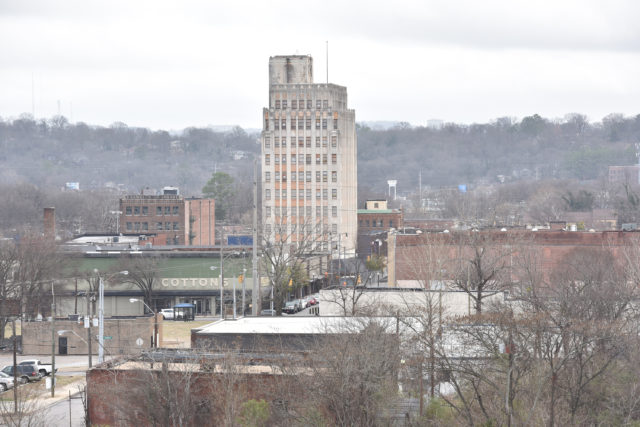
By Erica Wright
The Birmingham Times
Sixteenth Street Baptist Church is just one of the Magic City’s historic landmarks being considered for preservation. The Arthur George “A.G.” Gaston Motel in downtown Birmingham and the historic Ramsay-McCormack building in downtown Ensley are also on the list.
Preservation efforts are important “because they connect our collective memory to places that hold lasting significance in our everyday lives,” said City of Birmingham Director of Cultural Preservation Denise Gilmore.
“Preservation of our heritage and history today will be a bridge to future generations.”
Ramsay-McCormack Building

In September, more than 30 developers, architects, planners, and realtors did a walkthrough of the Ramsay-McCormack building, also known as the Bank of Ensley building, in downtown Ensley—the first steps toward preserving the site.
“They were able to get a feel for the building and were able to see its current state and to help inform their responses to the proposal,” said Gilmore.
The request for proposals from developers interested in working on the building began in August and closed October 15; the city will select the developer by November 15. Gilmore predicts that work will begin in 2019.
The Ramsay-McCormack building—a 10-story, 144-foot-tall office tower completed in 1929 and located on the corner of Avenue E and 19th Street Ensley—is named after investment partners Erskine Ramsay and Carr McCormack of the Ramsay-McCormack Development Co.; it was designed by architect Brooke Burnham.
“At the time, its significance was that it was a site of commerce and it was the tallest building in any suburban city in the South when it was completed,” said Gilmore. “[Several] doctor’s offices, attorneys, banks, and professional services and offices were located there, and it was a center of commerce and entrepreneurship in Ensley. [Part of] its historic significance is the fact that it was a tall skyscraper and the center of commerce.”
The Ramsay-McCormack building housed the Bank of Ensley on the ground floor, as well as the developer’s offices and local offices for U.S. Steel for several years. Despite a renovation in 1970, the closure of U.S. Steel’s Ensley Works left much of the tower vacant, and the building’s doors were closed in 1979. The city of Birmingham acquired the building in 1983 for $1, and it was listed on the National Register of Historic Places in 1984, but it has been empty since 1986. After acquiring the building, the city talked about possible renovation efforts.
In 2016, former Birmingham Mayor William Bell announced that the building would be renovated as part of a $40 million project to create a public safety complex, combining the Birmingham Municipal Court, Birmingham Police Headquarters, and Birmingham Fire and Rescue Service administrative offices, along with green space and new retail and residential projects to be developed by the Bethel-Ensley Action Task nonprofit.
When Mayor Randall Woodfin was elected in October 2017, plans to use the building as a public safety complex were scrapped. The mayor did get City Council approval for $83,500 to remove windows and other potential dangers to the surrounding sidewalks; he also solicited proposals from private developers for renovation plans.
Gilmore said the Ramsay-McCormack building is eligible for Historic Tax Credits, an incentive that provides a tax credit to investors for rehabilitating significant historic properties listed on the National Register of Historic Places, bringing equity to a potential developer that will help reduce the overall costs in addition to other incentives that may be available.

Cultural Preservation for City of Birmingham. (Ariel Worthy Photo, For The Birmingham Times)
“The historic preservation of the Ramsay-McCormack building does two things, Gilmore said. “One, it gives the neighborhood itself an opportunity to be a catalyst for other revitalization throughout downtown Ensley; and, [two], it reactivates that space, [creating] … an opportunity to perhaps have mixed-use again, so it could be commercial or retail [space] and have some combination of other uses.”
Arthur George “A.G.” Gaston Motel

Named after the prominent Birmingham businessman, the A.G. Gaston Motel was constructed in 1954 to provide higher-class service to black visitors in the midst of the city’s decades of strictly segregated business and recreation. The motel also served as a home for countless Civil Rights Movement leaders, serving as a meeting place when they traveled through Birmingham.
During the pivotal spring of 1963, the Rev. Dr. Martin Luther King Jr. stayed in room 30—a “War Room” for the movement’s top leaders. The motel is where King made the decision to defy a court injunction and submit himself to being jailed as a show of solidarity with local protesters. It’s where King and other Civil Rights icons, notably the Rev. Ralph Abernathy and the Rev. Fred Shuttlesworth, announced an agreement with white business leaders and city officials. Two days after the leaders took that historic stance in the motel’s courtyard, a pair of bombs were set in response to the agreement; they exploded near King’s room and destroyed most of the motel’s facade.
The motel sat vacant for more than 20 years, but in 2016 the city deeded over a portion of the property to the National Trust for Historic Preservation for the purpose of establishing a Birmingham Civil Rights National Monument.

“We’re currently working with our architect and with the National Park Service to help define the actual design of the motel,” Gilmore said. “[We plan to begin with] exterior restoration of the 1954 portion of the motel, where the War Room [is located], the [place where] Civil Rights leaders met to plan Project C in 1963. The first phase of the restoration will be the exterior of that side of the motel, as well [the installation] a new roof on the entire . . . structure.
“We anticipate that the restoration will start before the end of this year, and we’re hoping for a November or December time frame [during which] contractors will begin predevelopment work on the restoration.”
After the A.G. Gaston Motel site is restored, it will be annexed by the Birmingham Civil Rights Institute and will become the new Freedom Center, an educational hub that will focus on the Civil Rights Movement and other cultural topics.
For more information about the efforts to preserve Birmingham’s historic sites, visit www.birminghamal.gov or www.nps.gov.
Click here to read more preservation stories: Wales Window; List of Sites.




